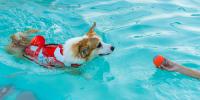How to Teach a Dog to Swim


Many pet owners wonder how to teach a dog to swim – and for good reason. Swimming can be a really fun activity for your canine.
In addition to being a calorie-burning workout, swimming provides an opportunity to play an exciting game of water-fetch (and a chance to earn treats as your pet learns the ropes).
Plus, as a low-impact activity, paddling is beneficial for dogs who suffer from joint and arthritis pain.
You may be surprised to learn, however, that not all canines love to swim. While some breeds are naturally adept, others struggle in, or are scared of, the water.
Whether your pet is eager to dive in or afraid to get wet, these tips can help teach your dog to swim.
Know Your Dog
Breeds such as Retrievers, Setters and Spaniels usually – though not always – enjoy swimming. These canines were historically bred to navigate water, often while retrieving game for hunters.
Breeds like Pugs and Bulldogs should always be supervised around lakes, pools, ponds and the ocean. With short snouts and legs as well as broad chests, it can be difficult for them to stay afloat. They are not naturally strong swimmers, have trouble breathing and can easily drown.
Even if you think your dog should enjoy water, though, don’t force them in if they show signs of fear.
Introduce Your Dog to Water Gradually
No matter your dog’s ability or age, they’ll need an introduction to water.
Teaching a Puppy to Swim
If you’re wondering how to teach a puppy to swim, fill a kiddie pool with enough water to reach the first joint on your pet’s front leg. This contained space is especially helpful for small puppies.
Encourage them by tossing in a toy or getting in yourself. As your puppy becomes acclimated, you can work your way up to a larger body of water.
You may also increase your chances of instilling a lifelong love of the water if your pet is exposed to swimming during the first three months of their life. This is a critical socialization period where they’re absorbing information about their environment.
Teaching a Dog to Swim
For dogs that are older and bigger than puppies, you don’t necessarily need to start swimming lessons in a kiddie pool. The shallow end of a pond, lake or swimming pool will also work.
Your pet may or may not be curious about the water. To entice them, offer treats every time they move closer.
Also try setting their favorite toy on the surface of the water but within their reach. Reward with another treat if they grab it. Repeat this process, setting the toy slightly farther out each time. Keep the setting positive and ensure your dog is having a good experience.
Once they’ve entered the water up to their belly and seem comfortable, support them under their midsection and hindquarters, and slowly move deeper into the water. They should start paddling on their own, although it may be a little uncoordinated at first.
After they’ve figured out their paddle, encourage them to swim to you at a depth that would be over their head.
Remember, you may need several attempts across different days to teach your dog to swim. Also, if they seem overly anxious at any time, stop the lesson and try again another time.
Wear a Life Vest
Just like children wear floaties in the water before they can swim, a life vest may boost your dog’s confidence as well as keep them safe. Some breeds that aren’t good swimmers may have to wear a life vest forever. Keep in mind if you go boating, even strong dog swimmers should have a life vest available.
Introduce the life vest gradually, offering treats to your pet while showing it to them. After they seem comfortable, have them walk under it. This creates the impression that they’re putting it on themselves.
If they’re calm with the vest resting on their backs, snap the buckles together while giving a treat. Before you head for the water, let them wear the life jacket for short periods of time until they get used to it.
Follow the Leader
If your family or friend has another dog that’s already comfortable in the water, bring them along for the swimming lesson. This can help them learn by example.
Be Selective About Water Toys
Playing fetch can be a great way to spend time in the water but choose your toys carefully. Select an object that floats, as these are easier to retrieve.
Also be mindful of size. Over- or awkward-sized toys may disrupt your pet’s swimming if they have to work hard to snatch them.
Things to Avoid
For pet parents wondering how to be safe in the water while teaching a dog to swim, keep these caution tips in mind:
- “Sink or swim” is not a fun game for children or dogs, so you should never just throw your pet in the pool.
- Don’t let your pet drink from the water in which they’re swimming. Chlorine and salt water can cause gastrointestinal and electrolyte problems.
- Don’t leave your canine unattended. Even competent swimmers should be supervised.
- In the ocean, beware of currents, powerful surf and undertow.
Have Fun!
As they learn how to swim, praise your dog with lots of love, attention and toys. Making the experience fun will increase the chances that they’ll want to do it again.
Get more training tips for your dog from our experts on our Pet Expertise page.
Related articles

Reward Yourself with myPurina
Earn and redeem rewards for Purina products with the myPurina app.






